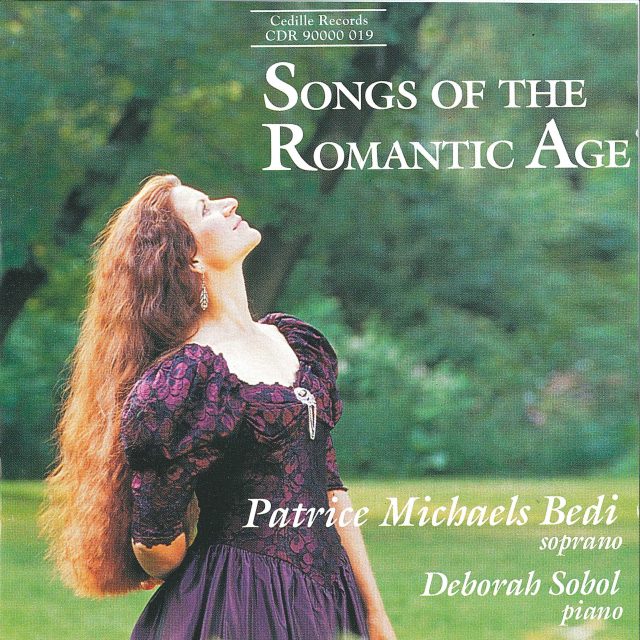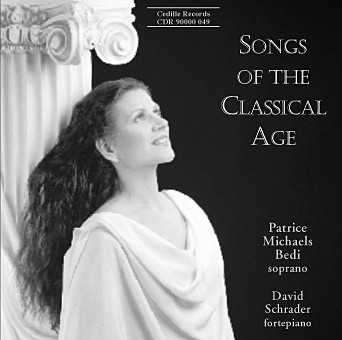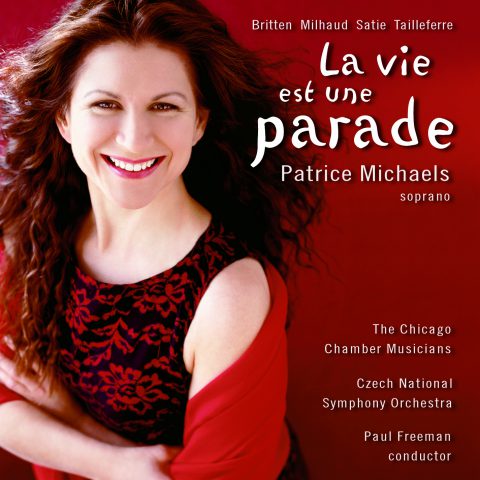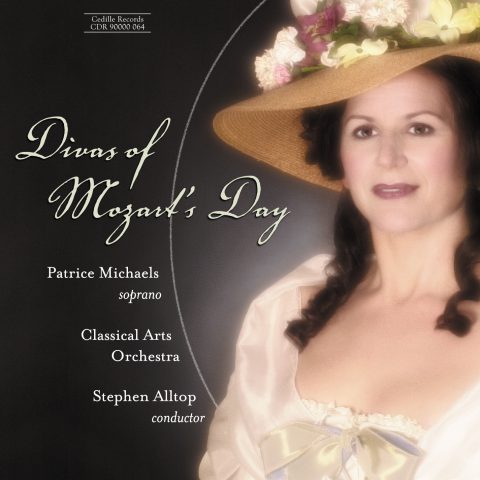| Subtotal | $18.00 |
|---|---|
| Tax | $1.85 |
| Total | $19.85 |
Store

Coloratura soprano Patrice Michaels, best-known for her interpretations of Mozart, baroque, and contemporary music makes her solo recording debut with 25 Romantic songs by 25 composers on this CD.
But why is Ms. Michaels emphasizing music that’s outside her “specialty”? “It’s something I think all singers should be able to do,” she says. “A couple generations ago, it wouldn’t have seemed odd. The best singers were expected to perform Rachmaninov as well as Handel”
The disc showcases Ms. Michaels’ bel canto vocalism through a comprehensive collection of songs spanning 85 years and 8 languages. Alongside works by vocal stalwarts Fauré and Schumann are rarely recorded songs by Godard, Pierné, Medtner, Mussorgsky, Resphighi, and even Chopin.
The songs are grouped on the CD according to national flavor: France is represented by Godard, Debussy, Chausson, Bachelet, Fauré, and Pierné; Poland, by Chopin; Germany, by Schumann, Mendelssohn, Medtner, Brahms, Wolf, and Strauss; Russia, by Stravinsky, Mussorgsky, Tchaikovsky, Rachmaninov, and Prokofiev; America, by Ives and Ganz; Scandinavia, by Sibelius; Italy, by Donaudy and Respighi; and Spain, by Falla and Delibes (a French composer whose song is very Spanish in character).
Preview Excerpts
BENJAMIN GODARD (1849-95)
CLAUDE DEBUSSY (1862-1918)
ERNEST CHAUSSON (1855-99)
ALFRED BACHELET (1864-1944)
GABRIEL FAURÉ (1945-1924)
GABRIEL PIERNÉ (1863-1937)
FRÉDÉRIC CHOPIN (1810-49)
ROBERT SCHUMANN (1810-56)
FELIX MENDELSSOHN’S (1809-47)
NIKOLAI MEDTNER (1880-1951)
JOHANNES BRAHMS (1833-97)
HUGO WOLF’S (1860-1903)
RICHARD STRAUSS (1864-1949)
IGOR STRAVINSKY (1882-1971)
MODEST MUSSORGSKY (1839-81)
PIOTR ILYICH TCHAIKOVSKY (1840-93)
SERGEI RACHMANINOV (1873-1943)
SERGEI PROKOFIEV (1891-1953)
CHARLES IVES (1874-1954)
RUDOLPH GANZ ( 1877-1972)
JEAN SIBELIUS (1865-1957)
STEFANO DONAUDY’S (1879-1925)
OTTORINO RESPIGHI (1879-36)
MANUEL DE FALLA (1876-1946)
LÉO DELIBES (1836-1991)
Artists
Program Notes
Download Album BookletSongs of the Romantic Age
Notes by David Ross Hurley
The art song has had an almost universal appeal among composers, performers, and listeners over the last two centuries. While songs make up a major portion of the output of some composers (such as Schumann and Fauré), even those composers more strongly associated with other genres have found a special affection for the art song. The form has proved an attractive outlet for expression crossing national boundaries and artistic schools. Thus, the songs represented on this program encompass eight distinct national styles and range chronologically from 1837 to 1921.
All of the French composers represented in this recital either taught or studied at the prestigious Paris Conservatory. Claude Debussy (1862-1918) began his studies at the Conservatory at the precocious age of ten. Paysage sentimental, composed in 1883, is an early impressionistic work in which the melodic line is subservient to the “accompanimental” harmonies. Ernest Chausson (1855-99) studied with Jules Massenet at the Conservatory followed by private lessons with César Franck. Le Colibri (The Hummingbird), from Chausson’s Op. 2 songs of 1882, is a passionate setting of a classically Romantic poem that compares a lover’s kiss to the ecstatic death of a hummingbird that “drinks too much from the rosy cup.” Another Paris Conservatory product, Alfred Bachelet’s (1864-1944) experience as an opera composer influenced his songs, including the sumptuous Chère Nuit, which he wrote for the celebrated Australian soprano, Nellie Melba.
Benjamin Godard (1849-95) entered the Conservatory at the age of fourteen and published his first work, a violin sonata, two years later. While Godard may be most celebrated for his 1888 opera Jocelyn, he did compose over 100 songs, of which Chanson de Juin is a particularly enchanting example. Gabriel Fauré (1945-1924) was a prolific composer of songs whose well-crafted opuses, like the charming Chanson d’Amour, inspired contemporaries such as Debussy and Chausson. From 1896, Fauré also influenced young composers as a teacher at the Conservatory, where he served as director from 1905 to 1920. Gabriel Pierné (1863-1937), whose breezy Serenade is typical of his lilting style, was also an alumnus of the Conservatory, where he studied organ with Franck and composition with Massenet.
The German Lied is generally viewed as the dominant form of nineteenth-century art song. After Schubert, perhaps no composer contributed more significantly to the development of this revered genre than Robert Schumann (1810-56). The somber Ich hab’ in Traum geweinet (In a dream I wept) comes from Schumann’s 1840 song cycle Dichterliebe (Poet’s Love), Op. 48. Also from 1840 but in a lighter vein is Felix Mendelssohn’s (1809-47) lovely strophic lullaby, Bei der Wiege (At the Cradle), Op. 47, No. 6. Separating works by the early and late nineteenth century German song composers is a Lied by the Russian composer Nikolai Medtner (1880-1951). One of the finest pianists of his time, Medtner left Russia for Germany in 1919 and settled in Paris in 1925. Although Medtner is best known for his piano works, he also wrote around 100 songs very much in the German Romantic tradition, including the bittersweet Erster Verlust (First Loss).
Of the later composers of Lieder, Johannes Brahms (1833-97) was perhaps the most strongly influenced by folksongs; his songs are largely diatonic and do not contain lengthy introductions and postludes. The wistful Nachtigall (Nightingale) is the first in Brahms’s Op. 97 set of 1884-85. Hugo Wolf’s (1860-1903) Italienisches Liederbuch is a collection of anonymous lovesong settings that includes Wie lange schon war immer mein Verlangen (How long have I pined for a musician’s love). The song is reminiscent of Schumann and includes an amusing postlude depicting the not-so-competent playing of a violin. Appropriately concluding this group is a work by the last of the great Lieder composers, Richard Strauss (1864-1949), who wrote his characteristically sparkling Ich schwebe (I float), Op. 48, No. 2 in 1900.
Although Frédéric Chopin (1810-49) is known almost exclusively as a composer of music for solo piano, he wrote many songs, often as gifts for potential amours. His dance-like Moja Piesczotka (My Darling), Op. 74 No. 12 from 1837 evokes the character of a mazurka in which Chopin’s characteristic musical nationalism is intensified by the use of a Polish text. As a young man, Manuel de Falla (1876-1946) was deeply impressed by the nationalistic vein of Edward Grieg’s music. Falla aspired to achieve a similarly distinct Spanish idiom in his own music. This aspiration is already achieved in his early (1902) Andalusian song Tus ojillos negros (Your little black eyes).
Like many of the composers on this program, Ottorino Respighi (1879-36) is known almost exclusively for his orchestral compositions. Works like the lush O falce di luna (O sliver of moon), however, suggest that Respighi’s skill as a writer of songs may not be sufficiently appreciated. Stefano Donaudy’s (1879-1925) Arie di stile antico is a collection of songs, each modeled on a specific older genre such as the villanella and the madrigal. Beyond their neo-renaissance orientation, songs from this set like O del mio amato ben are unabashedly Italianate in style, marked by a melody-dominated texture and an immediacy of appeal characteristic of Italian opera.
Igor Stravinsky (1882-1971) dedicated his 1907 vocalize entitled Pastorale to Nadezhda Rimsky-Korsakov, wife of Stravinsky’s famous teacher. Atypical for Stravinsky, this playful piece has the lyrical feeling of a French chanson. Modest Mussorgsky (1839-81) was the greatest genius of the “Mighty Handful” of Russian nationalist composers who preceded Tchaikovsky. Although most celebrated for his great opera Boris Godunov, Mussorgsky wrote beautiful songs from the beginning of his musical career, as his melancholic O, my little star of 1857 demonstrates. In the late nineteenth-century, the Russian art song became dominated by the romance, a sentimental form akin to the Victorian drawing-room ballad. Many of Piotr Ilyich Tchaikovsky’s (1840-93) over 100 songs are of this type, including the sorrowful, distinctly Russian Was I not a blade of grass, Op. 47, No. 7. The bush on the hill, Op. 104, No. 3 is characteristic of the more melodic, less acerbic music Sergei Prokofiev (1891-1953) wrote in his last years. This bright song is actually an authentic folk tune that Prokofiev ingeniously harmonized. The songs of Sergei Rachmaninov (1873-1943) reflect his brilliance at both piano writing and melodic invention. The impressive Op. 34 songs, including The Muse, feature simple melodies and piano inflections designed to emphasize particular words.
With more than 100 songs to his credit, it is surprising that the great Finnish composer Jean Sibelius (1865-1957) is thought of almost exclusively as a writer of orchestral music. Sibelius’s harmonically exotic 1917 song Norden (From the North), set to a Swedish text, is considered one of the strongest of his Op. 90 set. Charles Ives (1874-1954) is known primarily as a composer of thorny, transcendentally complex works like the “Concord” Sonata, but Two Little Flowers proves there is a softer side to his artistry. Ives wrote the words and music to this affectionate song about his own daughters in 1921, describing them as “the fairest, rarest [flowers] of all.” The Swiss-American Rudolph Ganz (1877-1972) trained as a pianist and conductor in Switzerland and Berlin, and emigrated to the United States in 1901, where he served as director of the Chicago Musical College from 1929 to 1954. His tender song A Memory first appeared in 1919.
Before de Falla, it could be said that the best Spanish Music was written by Frenchmen. Such Spanish flavor permeates Leo Delibes’s (1836-91) delightful parlor aria Les filles de Cadix, a perfect showpiece to conclude this wife-ranging program.
— David Ross Hurley
Album Details
Total Time: 68:42
Recorded: June 20-22 & 27, 1994 in Ganz Hall at Roosevelt Universities Chicago Musical College
Producer: James Ginsburg
Engineer: Bill Maylone
Cover: Photograph by Kathy Richland
Design: Cheryl A Boncuore
Notes: David Ross Hurley
© 1994 Cedille Records/Cedille Chicago
CDR 90000 019


